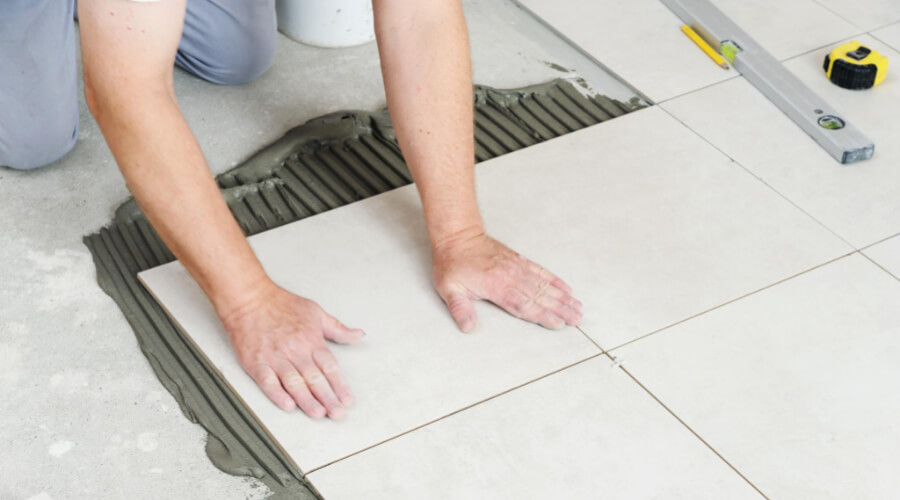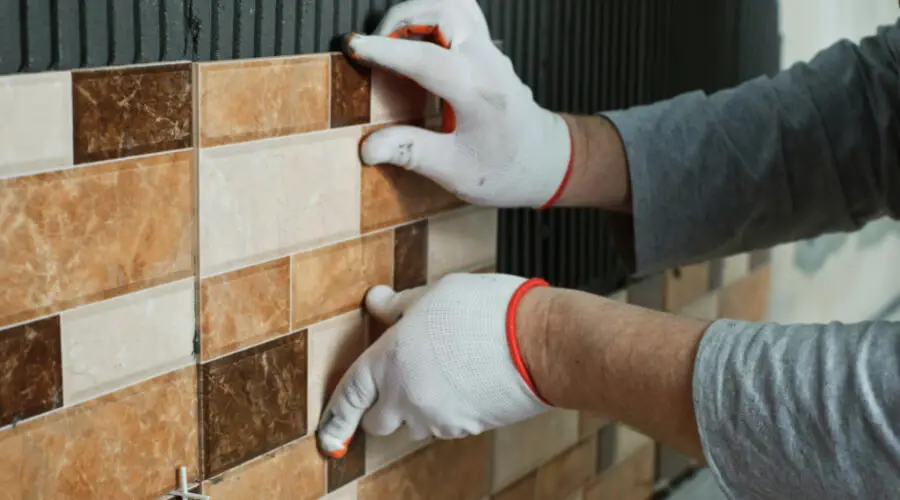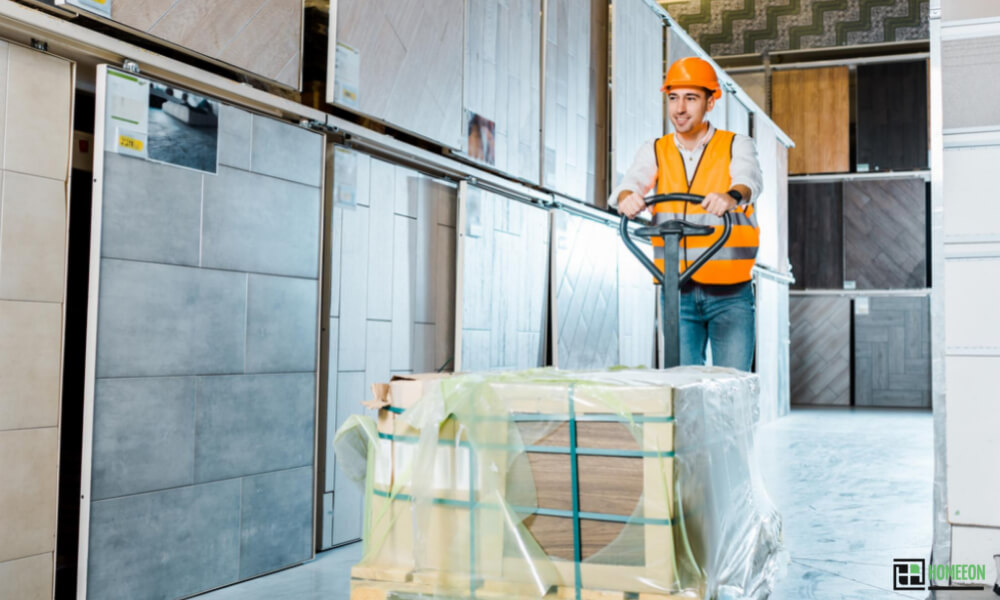Last Updated on July 13, 2023 By Emma W. Thomas
Soaking tiles in water before use is a common practice to prevent them from absorbing excessive moisture from the adhesive or grout during installation. This process, known as back buttering or back soaking, allows the tiles to reach a state of saturation, reducing their ability to absorb water from the setting materials. Soaking helps to improve the bond between the tiles and the adhesive, ensuring better adhesion and minimizing the risk of tiles cracking or loosening over time. It also aids in preventing color variations or efflorescence issues that can arise from moisture absorption.
What Are The Main Reasons For Soaking Tiles?

There are various reasons why you need to soak your tiles before laying them, including;
Strengthening The Bond Between Tile And Binder
Ceramic tiles absorb water at high rates, and laying them without soaking may lead to weak bonds between the binder and the tiles. The tiles absorb moisture from the adhesive or cement paste, leaving less water for curing or hydration. As a result, the weak bonds will result in the cracking of the tiles.
It Helps To See Any Defects On The Tiles.
Your tiles may get damaged during transportation from one place to another. For example, transporting them from the factory to the store or worksite may cause defects. Since the damage occurs at the back of the tile (the glaze is hard and not easy to break), it may not be easy to spot. This damage may be visible on the glaze after the installation process. If the tiles are soaked in water for about 2 hours before laying, it will help locate any defect.
A defective title will break when removed from the water after soaking at the crack point. Doing this will help prevent the trouble of replacing the tiles after the installation process.
Remove Any Oil Coating.
Oil is used during the manufacture of tiles, leaving a film on the tiles’ back surface. Since oil is less dense than water, soaking the tiles helps to remove all the oil coating which floats on the water’s surface. This process is only applicable where tile manufacturers use oil. The practice may, however, be outdated.
Why are Ceramic Tiles Soaked in Water Before Use?
Ceramic tiles are a popular choice for flooring and wall coverings in both residential and commercial spaces. Before they are installed, however, it is common practice to soak these tiles in water. This pre-installation step may seem peculiar to some, but it actually serves several important purposes. Let’s explore why ceramic tiles are soaked in water before use:
- Enhancing Adhesion: Soaking ceramic tiles in water before installation helps to enhance the adhesion between the tile and the adhesive or mortar used. This is especially crucial for floor tiles that endure heavy foot traffic or wall tiles that are exposed to humidity. Water absorption by the tile effectively saturates it, allowing for better adhesive penetration and creating a firmer bond.
- Preventing Tile Shrinkage: Ceramic tiles are made from a mixture of clay and other natural materials, which are then baked at high temperatures to form the final product. By soaking the tiles in water, any residual moisture within the tile is reabsorbed, preventing further shrinkage during the installation process. This helps the tiles maintain their original shape and size, ensuring a perfect fit when installed.
- Minimizing Surface Staining: Soaking ceramic tiles in water before installation can also help minimize surface staining. During the manufacturing process, tiles can accumulate dirt, dust, and other particles on their surface. Soaking the tiles allows these particles to loosen and detach, making it easier to clean before installation. This ensures that the tiles remain pristine and free from any unsightly marks or blemishes.
- Reducing Installation Time: By soaking ceramic tiles in water, they become more pliable and easier to work with. This increased flexibility allows for smoother and faster installations, as the tiles can be maneuvered more easily into position. This is particularly beneficial for complex or intricate tile layouts, where precision and efficiency are key.
- Improving Longevity: Soaking ceramic tiles in water before installation can also contribute to their long-term durability. By ensuring proper adhesion and reducing the risk of shrinkage, the tiles are less likely to crack, break, or become loose over time. This helps maintain the integrity of the tiled surface and ensures that it will endure the test of time.
How Long Should You Soak Tiles?
- Ceramic Tiles:
Ceramic tiles are popular due to their durability and versatility. These tiles are ideal for various areas of your home. To prepare ceramic tiles for installation, soaking them for approximately 5-10 minutes is generally sufficient. This allows the tiles to absorb enough moisture, making them easier to apply and preventing them from drawing moisture from the adhesive too quickly.
- Porcelain Tiles:
Porcelain tiles are known for their water resistance and durability, making them suitable for both indoor and outdoor applications. When soaking porcelain tiles, it is recommended to extend the duration to around 15 minutes. This extra soaking time allows the tiles to fully absorb water, reducing the risk of them absorbing moisture from the adhesive during installation.
- Natural Stone Tiles:
Natural stone tiles, such as marble, granite, or travertine, offer a touch of elegance and sophistication to any space. These tiles require a longer soaking time compared to ceramic or porcelain tiles. Soaking natural stone tiles for approximately 20-30 minutes is advisable. This extended duration allows the porous stone to absorb enough water, preventing it from drawing moisture from the adhesive and ensuring better adhesion.
- Glass Tiles:
Glass tiles are known for their exquisite appearance and ability to reflect light, creating a stunning visual impact. For glass tiles, soaking them for a brief period is crucial to avoid any damage. A soaking duration of around 5-7 minutes is typically sufficient. Since glass tiles are non-porous, they don’t require as much water absorption as other tile types, making them less prone to moisture-related issues during installation.
- Mosaic Tiles:
Mosaic tiles consist of smaller pieces arranged in a pattern, offering a unique and artistic touch to any space. Soaking mosaic tiles for around 10-15 minutes is generally recommended. The soaking process allows the individual pieces to absorb moisture evenly, contributing to easier installation and ensuring a uniform appearance.
What Are The Essential Factors To Consider Before Soaking Tiles?

Before you can soak your tiles, there are several factors to consider, including;
Material Making The Tile
The material from which the tiles are made plays a vital role in deciding whether they can be soaked or not. For example, if your tiles are stone-based, you will not need to soak them before laying. But, the tiles made of white or red clay should be soaked. Soaking the red tiles helps to increase their strength and enhance bonding.
If you have ceramic or porcelain tiles, you can use a brush to moisten the clay layer below the top layer. You may also sprinkle the tiles with a little water to make them wet. The table below summarizes different tiles and what needs to be done.
Type of tile | What to do to them |
Stone-based | No need to soak |
Red clay | They need soaking to enhance bonding and increase strength. |
White clay | Soaking improves bonding |
Porcelain | Sprinkling or rinsing is enough. |
Ceramic | Only a few types require rinsing or sprinkling. |
The Tile’s Thickness
Before deciding on whether to soak your tiles or not, it is necessary to know their thickness. For example, the tiles whose thickness is less than 1cm need not be soaked but just washed. You can use a brush, sponge, or even splash. For thicker tiles, be sure to soak them and allow them to dry a little. Doing this will help prevent the tiles from slipping when you place them on the cement or adhesive.
If They Are Dusty Or Not
If your tiles have been in the warehouse for a long period, they will have a lot of dust on them. Such tiles will not look good upon installing them and need cleaning before you can soak them. You can moisten and wipe granite tiles for dust using a damp sponge. But, it is necessary to rinse the sponge after cleaning each tile.
Quality Of Water Used.
The quality of water used to soak the tiles influences the outcome. For example, using freshwater will prevent fungi or bacteria infestation, unlike water from the lake. Be sure to avoid using detergents, whether in liquid or powder form, as using these substances may form an oily layer above the tiles. Such layers will reduce the effectiveness of the adhesive.
What Are The Effective Ways To Wet Or Soak The Tiles?
There are different ways to wet or soak your tiles depending on the material making them and their thickness. For wetting the tiles, you can either use a sponge or brush as follows;

Using A Brush
You will need to soak the brush in water and allow it to get as much water as possible. Make sure enough water seeps into the bristles by rubbing the brush against the walls of the container underneath the water. Remove the brush from the water while taking care not to let the excess liquid drip off. Stroke the tiles twice in an up-and-down motion to ensure they are properly covered with water.
Using A Sponge
If you want to use a sponge to wet your tiles, you need to submerge it inside the water and let them soak enough water. After completely soaking, you can pick it up and squeeze it gently to remove excess water and avoid dripping. Pass the sponge over the tiles two times. Doing this ensures the tiles are wet enough for laying.
Soaking
If the tiles you are working with need soaking, you can get yourself a large bucket and fill it with water. Make sure that you lay the tiles flat while stacking them on top of each other. Avoid balancing the tiles as they may fall and break when you try to remove them.
You can leave the tiles in water for about 20 to 30 minutes to absorb an adequate amount of water. If the tiles produce a fizzing sound, allow it to stop before pulling them out. This fizzing is an indication that they are releasing air and absorbing water.
Conclusion
Soaking tiles in water is necessary to prevent them from cracking after laying. Ceramic tiles have a high water absorption rate, making them absorb water from the adhesive or cement paste if they are not soaked before. Soaking helps strengthen the bond between the tiles and binder and it also makes any defect visible. It also prevents the tiles from falling off over time.
When the pores in the tiles absorb water fully, it will help prevent cracking, hollowing, or shedding. The process ensures that the tiles will stick properly and make them last longer.
References:
https://gharpedia.com/blog/bricks-soaked-in-water/
https://ctasc.com/expert-answers/why-is-water-suddenly-seeping-through-my-tile-grout-joints/
Emma is a graduate of Domestic Science or Family and Consumer Sciences (Home Economics) from the University of Wisconsin. She has 7 years of experience Working with the strategic section of BestBuy and now writing full-time for Homeeon.
From Managing the Home, Interiors, Cleaning, and Exteriors to Gardening and everything about Making A Home Liveable – is her passion and this Homeeon is the result of this.
Emma loves decorating her home with the best stuff found online. She cares about quality over anything and writes reviews about them here in Homeeon. Get in touch with her over Pinterest.
Keep reading her blogs.

